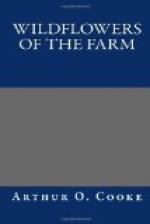We are soon at the field, and there is no mistake about the flowers being there too. Close to the gate, where the wheat is not quite so thick as elsewhere, there is a splendid patch of scarlet poppies. This is perhaps the very brightest wild flower that we have.
Some plants, as we have seen, are annuals, others are perennials. An annual only lives for one year. The plant springs up from the seed, grows through the summer, and in the autumn or the winter dies. A perennial lives for many years. The flowers fade and fall as those of annuals do; even the leaves and stems may droop and die. The roots and lower part of the stem do not die; they live in the ground through the winter, and in the following year fresh stems appear. The White Clover which we found in Ashmead is a perennial, the Crimson Clover is an annual.
If you sowed a patch of your garden with Poppy seed you would have the flowers growing there year after year. You might therefore say, “Surely the Poppy is a perennial. I only sowed the seed one year, yet the poppies appear again and again.” That is because the plants sowed their own seed. The flowers faded; then the seed-cases shed their seed upon the ground. Next spring the seeds produced fresh plants. Most annual wild flowers sow their own seed in this way, but we must not mistake them for perennials because year after year they grow in the same place.
In your patch of garden you can easily prevent the poppies from growing more than one year if you wish to do so. All that is necessary is to pick off every flower before it fades. Then no seed will fall and you will be rid of the poppies.
Mr. Hammond might do the same, you think, if he wishes to rid his field of poppies. But you see there are many poppies growing among the wheat all through the field. To get at each plant and cut off all the flowers would trample down the wheat and do more harm than good. All that the farmer can do is to have as many weeds as possible hoed up while the wheat is young and short. Even then many more come up later in the spring.
The seeds of the Poppy have no pappus like those of the Thistle and some other plants; they are not blown far away by the wind, but fall close to the plant. There are, however, an immense number of very tiny seeds in each seed-case, as we see by opening the round cup-like case on a stem from which the flower has fallen. This great number of seeds adds to the difficulty of getting rid of poppies.
We, I am afraid, are hardly sorry that the poppies are among the corn to-day. The glorious scarlet blossoms give a rich fiery tint to the whole field.
On a Poppy plant close to the gate there are several blossoms. Some of them are fully open, some of them are still only buds. You see a difference between the open flowers and the buds at once. The open flowers stand upright on the stalk; the buds hang down.
Here is a bud just opening. The green case, called the calyx, which contains the scarlet petals, is already partly open; it is splitting in half, and the flower will soon be out. Then the calyx will fall off.




